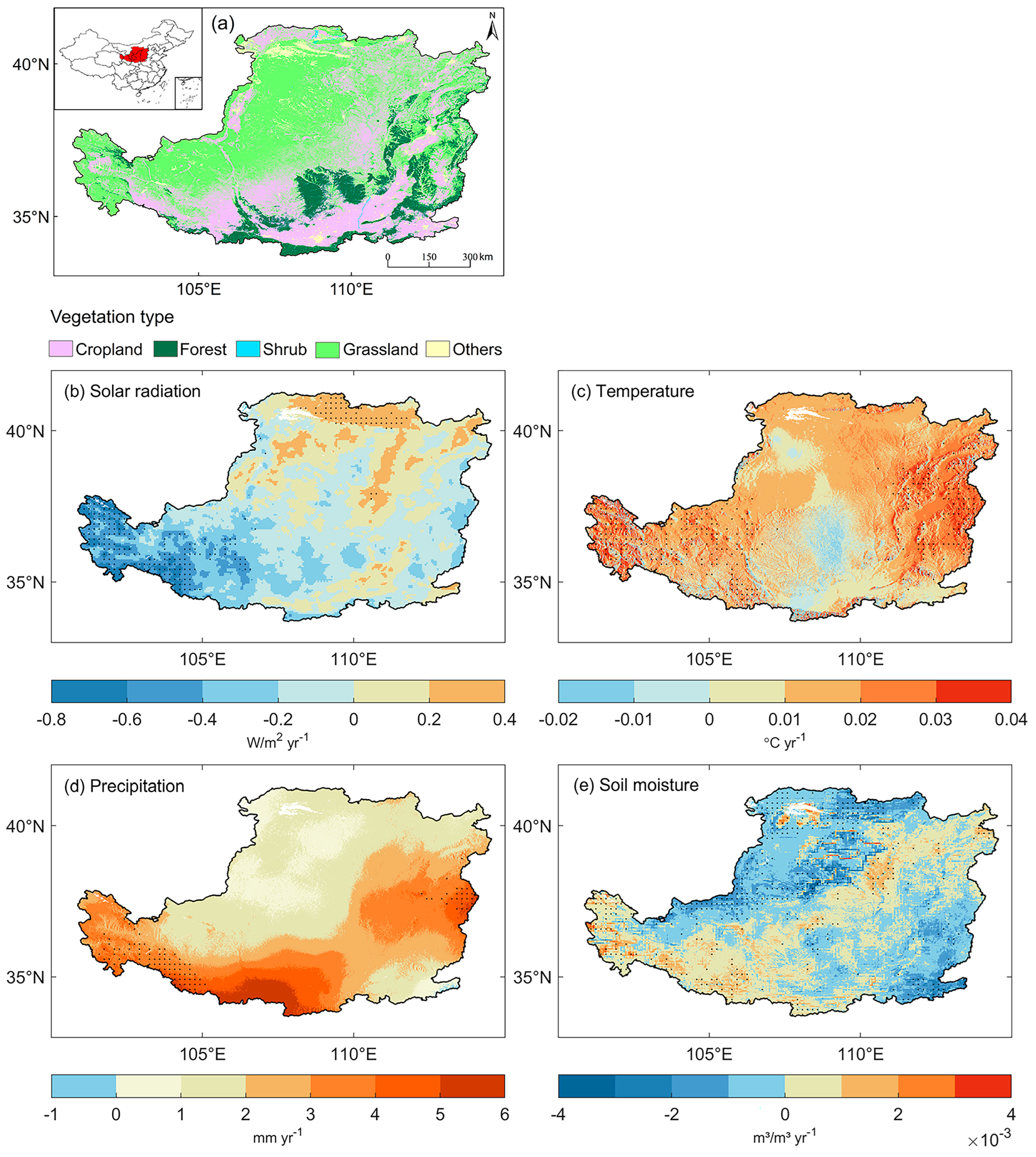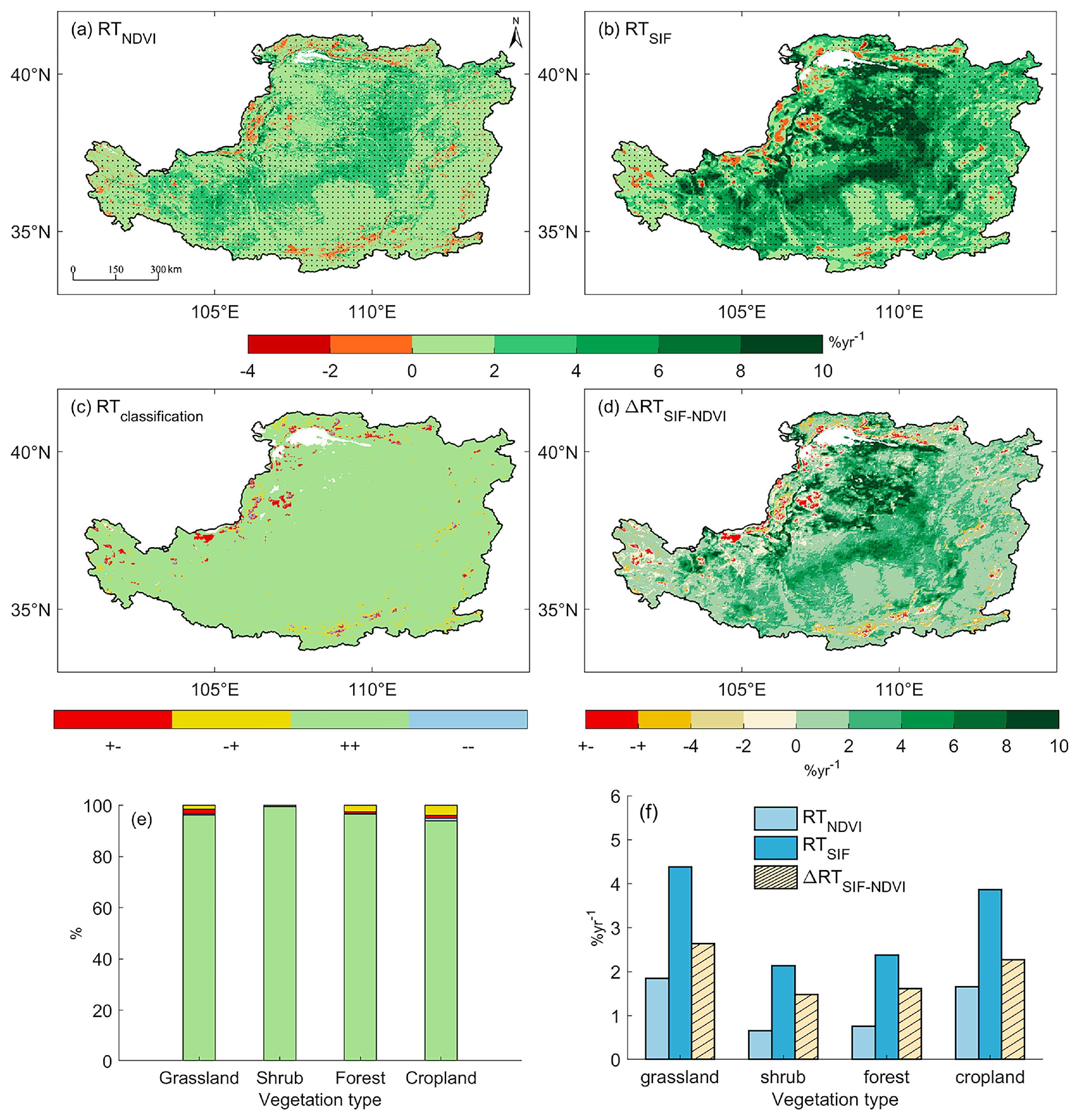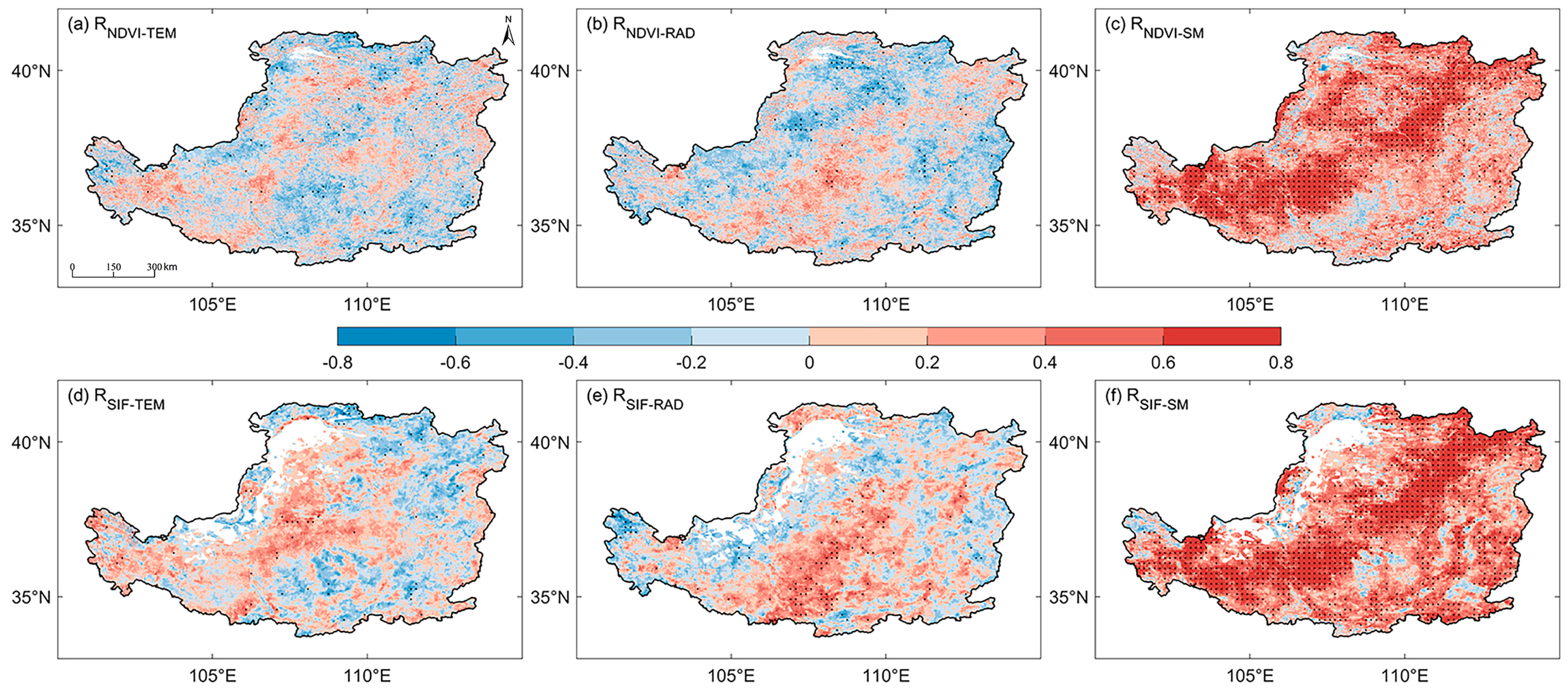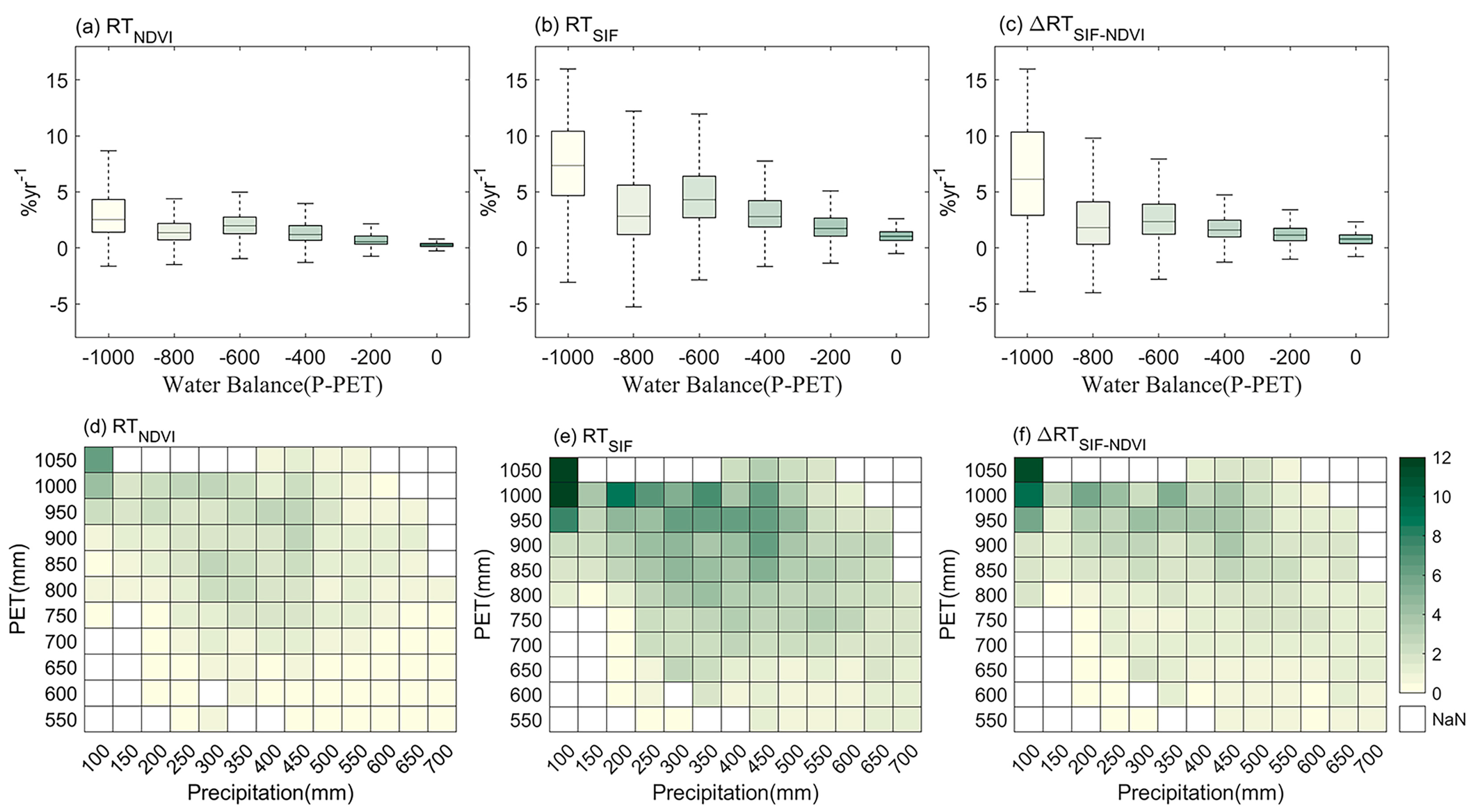Asynchronous Patterns Between Vegetation Structural Expansion and Photosynthetic Functional Enhancement on China’s Loess Plateau
Abstract
1. Introduction
2. Materials and Methods
2.1. Study Area
2.2. Datasets
2.2.1. Vegetation Indices
2.2.2. Climate Datasets
2.2.3. Land Cover and Digital Elevation Model (DEM) Datasets
2.3. Methods
3. Results
3.1. Vegetation Greenness (NDVI) and Photosynthetic Function (SIF) Changes: Trends and Climatic Controls
3.2. The Photosynthetic–Structural Enhancement Divergence (ΔRTSIF-NDVI) Across the Loess Plateau
3.3. Divergent Responses of Vegetation Greenness and Photosynthesis Across Plant Functional Groups
4. Discussion
4.1. Structural–Functional Asynchrony in Loess Plateau Vegetation Dynamics
4.2. Water Stress Amplifies Divergence Between Ecosystem Structure and Function on the Loess Plateau
4.3. Uncertainties
5. Conclusions
Supplementary Materials
Author Contributions
Funding
Data Availability Statement
Conflicts of Interest
References
- Poulter, B.; Frank, D.; Ciais, P.; Myneni, R.B.; Andela, N.; Bi, J.; Broquet, G.; Canadell, J.G.; Chevallier, F.; Liu, Y.Y.; et al. Contribution of semi-arid ecosystems to interannual variability of the global carbon cycle. Nature 2014, 509, 600–603. [Google Scholar] [CrossRef]
- Piao, S.; Wang, X.; Park, T.; Chen, C.; Lian, X.; He, Y.; Bjerke, J.; Chen, A.; Ciais, P.; Tømmervik, H.; et al. Characteristics, Drivers and Feedbacks of Global Greening. Nat. Rev. Earth Environ. 2019, 1, 14–27. [Google Scholar] [CrossRef]
- Fu, B.; Liu, Y.; Cao, Z.; Wang, Z.; Wu, X. Current conditions, issues, and suggestions for ecological protection and high-quality development in Loess Plateau. Bull. Chin. Acad. Sci. 2023, 38, 1110–1117. [Google Scholar]
- Fan, X.; Qu, Y.; Zhang, J.; Bai, E. China’s vegetation restoration programs accelerated vegetation greening on the Loess Plateau. Agric. For. Meteorol. 2024, 350, 109994. [Google Scholar] [CrossRef]
- Ma, Y.; Li, J.; Cao, W.; Huang, L. Grain for green program to grassland might lead to carbon sink leakage in the loess plateau. Earth’s Future 2025, 13, e2024EF005261. [Google Scholar] [CrossRef]
- Zheng, K.; Wei, J.Z.; Pei, J.Y.; Cheng, H.; Zhang, X.L.; Hunag, F.Q.; Li, F.M.; Ye, J.S. Impacts of climate change and human activities on grassland vegetation variation in the Chinese Loess Plateau. Sci. Total Environ. 2019, 660, 236–244. [Google Scholar] [CrossRef] [PubMed]
- Wang, Z.; Fu, B.; Wu, X.; Wang, S.; Li, Y.; Feng, Y.; Zhang, L.; Hu, Y.; Cheng, L.; Li, B. Distinguishing trajectories and drivers of vegetated ecosystems in China’s Loess Plateau. Earth’s Future 2024, 12, e2023EF003769. [Google Scholar] [CrossRef]
- Song, X.; Xie, P.; Sun, W.; Mu, X.; Gao, P. The greening of vegetation on the Loess Plateau has resulted in a northward shift of the vegetation greenness line. Glob. Planet. Change 2024, 237, 104440. [Google Scholar] [CrossRef]
- Gong, E.; Zhang, J.; Wang, Z.; Wang, J. Estimating the dynamics and driving factors of gross primary productivity over the Chinese Loess Plateau by the modified vegetation photosynthesis model. Ecol. Inform. 2024, 83, 102838. [Google Scholar] [CrossRef]
- Wu, H.; Zhou, P.; Song, X.; Sun, W.; Song, S.; Zhang, Y. Dynamics of solar-induced chlorophyll fluorescence (SIF) and its response to meteorological drought in the Yellow River Basin. J. Environ. Manag. 2024, 360, 121023. [Google Scholar] [CrossRef]
- Anniwaer, N.; Li, X.; Wang, K.; Xu, H.; Hong, S. Shifts in the trends of vegetation greenness and photosynthesis in different parts of Tibetan Plateau over the past two decades. Agric. For. Meteorol. 2024, 345, 109851. [Google Scholar] [CrossRef]
- He, L.; Guo, J.; Jiang, Q.; Zhang, Z.; Yu, S. How did the Chinese Loess Plateau turn green from 2001 to 2020? An explanation using satellite data. Catena 2022, 214, 106246. [Google Scholar] [CrossRef]
- Niu, Z.; He, H.; Yu, P.; Sitch, S.; Zhao, Y.; Wang, Y.; Jain, A.K.; Vuichard, N.; Si, B. Climate Change and CO2 Fertilization Have Played Important Roles in the Recent Decadal Vegetation Greening Trend on the Chinese Loess Plateau. Remote Sens. 2023, 15, 1233. [Google Scholar] [CrossRef]
- Li, G.; Sun, S.; Han, J.; Yan, J.; Liu, W.; Wei, Y.; Lu, N.; Sun, Y. Impacts of Chinese Grain for Green program and climate change on vegetation in the Loess Plateau during 1982–2015. Sci. Total Environ. 2019, 660, 177–187. [Google Scholar] [CrossRef]
- Zhang, T.; Tang, Y.; Xu, M.; Zhao, G.; Cong, N.; Zheng, Z.; Zhu, J.; Niu, B.; Chen, Z.; Zhang, Y.; et al. Soil moisture dominates the interannual variability in alpine ecosystem productivity by regulating maximum photosynthetic capacity across the Qinghai-Tibetan Plateau. Glob. Planet. Change 2023, 228, 104191. [Google Scholar] [CrossRef]
- Gou, Y.; Jin, Z.; Kou, P.; Tao, Y.; Xu, Q.; Zhu, W.; Tian, H. Mechanisms of climate change impacts on vegetation and prediction of changes on the Loess Plateau, China. Environ. Earth Sci. 2024, 83, 234. [Google Scholar] [CrossRef]
- Wang, S.; Zhang, Y.; Ju, W.; Chen, J.; Ciais, P.; Cescatti, A.; Sardans, J.; Janssens, I.; Wu, M.; Berry, J.; et al. Recent global decline of CO2 fertilization effects on vegetation photosynthesis. Science 2020, 370, 1295–1300. [Google Scholar] [CrossRef]
- Li, D.; Li, X.; Li, Z.; Fu, Y.; Zhang, J.; Zhao, Y.; Wang, Y.; Liu, Y.; Rossi, E. Drought limits vegetation carbon sequestration by affecting photosynthetic capacity of semi-arid ecosystems on the Loess Plateau. Sci. Total Environ. 2024, 912, 168778. [Google Scholar] [CrossRef]
- Tian, F.; Zhu, Z.; Cao, S.; Zhao, W.; Li, M.; Wu, J. Satellite-observed increasing coupling between vegetation productivity and greenness in the semiarid Loess Plateau of China is not captured by process-based models. Sci. Total Environ. 2024, 906, 167664. [Google Scholar] [CrossRef]
- Meng, F.; Liu, D.; Wang, Y.; Wang, S.; Wang, T. Negative relationship between photosynthesis and late-stage canopy development and senescence over Tibetan Plateau. Glob. Change Biol. 2023, 29, 3147–3158. [Google Scholar] [CrossRef] [PubMed]
- Tang, J.; Niu, B.; Hu, Z.; Zhang, X. Increasing susceptibility and shortening response time of vegetation productivity to drought from 2001 to 2021. Agric. For. Meteorol. 2024, 352, 110025. [Google Scholar] [CrossRef]
- Luo, Y.; Liang, W.; Yan, J.; Zhang, W.; Gou, F.; Wang, C.; Liang, X. Vegetation Growth Response and Trends after Water Deficit Exposure in the Loess Plateau, China. Remote Sens. 2023, 15, 2593. [Google Scholar] [CrossRef]
- Hu, Z.; Piao, S.; Knapp, A.K.; Wang, X.; Peng, S.; Yuan, W.; Running, S.; Mao, J.; Shi, X.; Ciais, P. Decoupling of greenness and gross primary productivity as aridity decreases. Remote Sens. Environ. 2022, 279, 113120. [Google Scholar] [CrossRef]
- Wei, F.; Wang, S.; Fu, B.; Wang, L.; Zhang, W.; Wang, L.; Nan, N.; Fensholt, R. Divergent trends of ecosystem-scale photosynthetic efficiency between arid and humid lands across the globe. Glob. Ecol. Biogeogr. 2022, 31, 1824–1837. [Google Scholar] [CrossRef]
- Wang, F.; Xia, J.; Zou, L.; Zhang, L.; Li, X.; Yu, J. Spatio-temporal heterogeneity and driving mechanism of ecosystem water use efficiency in the Loess Plateau, China. J. Hydrol. Reg. Stud. 2024, 56, 102012. [Google Scholar] [CrossRef]
- Zhang, Y.; Jiang, X.; Lei, Y.; Gao, S. The contributions of natural and anthropogenic factors to NDVI variations on the Loess Plateau in China during 2000–2020. Ecol. Indic. 2020, 143, 109342. [Google Scholar] [CrossRef]
- Liu, L.; Teng, Y.; Wu, J.; Zhao, W.; Liu, S.; Qiu, S. Soil water deficit promotes the effect of atmospheric water deficit on solar-induced chlorophyll fluorescence. Sci. Total Environ. 2020, 720, 137408. [Google Scholar] [CrossRef]
- Kimura, R.; Takayama, N. Climate of the Loess Plateau. In Restoration and Development of the Degraded Loess Plateau, China; Tsunekawa, A., Liu, G., Yamanaka, N., Du, S., Eds.; Ecological Research Monographs; Springer: Tokyo, Japan, 2014; pp. 23–33. [Google Scholar]
- Didan, K. MODIS/Terra Vegetation Indices 16-Day L3 Global 1km SIN Grid V061. NASA EOSDIS Land Processes DAAC. 2021. Available online: https://ladsweb.modaps.eosdis.nasa.gov/missions-and-measurements/products/MOD13A2 (accessed on 24 August 2025).
- Zhang, Y.; Joiner, J.; Alemohammad, S.H.; Zhou, S.; Gentine, P. A global spatially contiguous solar-induced fluorescence (CSIF) dataset using neural networks. Biogeosciences 2018, 15, 5779–5800. [Google Scholar] [CrossRef]
- Running, S.; Mu, Q.; Zhao, M. MOD17A2H MODIS/Terra Gross Primary Productivity 8-Day L4 Global 500m SIN Grid V006. NASA EOSDIS Land Processes Distributed Active Archive Center. 2015. Available online: https://ladsweb.modaps.eosdis.nasa.gov/missions-and-measurements/products/MOD17A2H (accessed on 24 August 2025).
- Peng, S.; Ding, Y.; Wen, Z.; Chen, Y.; Cao, Y.; Ren, J. Spatiotemporal change and trend analysis of potential evapotranspiration over the Loess Plateau of China during 2011–2100. Agric. For. Meteorol. 2017, 233, 183–194. [Google Scholar] [CrossRef]
- Peng, S. 1-km Monthly Mean Temperature Dataset for China (1901–2024); National Tibetan Plateau Data Center: Beijing, China, 2019. [Google Scholar] [CrossRef]
- Peng, S. 1-km Monthly Precipitation Dataset for China (1901–2024); National Tibetan Plateau/Third Pole Environment Data Center: Beijing, China, 2020. [Google Scholar] [CrossRef]
- Ding, Y.; Peng, S. Spatiotemporal change and attribution of potential evapotranspiration over China from 1901 to 2100. Theor. Appl. Climatol. 2021, 145, 79–94. [Google Scholar] [CrossRef]
- Peng, S. 1-km Monthly Potential Evapotranspiration Dataset for China (1901–2024); National Tibetan Plateau/Third Pole Environment Data Center: Beijing, China, 2022. [Google Scholar] [CrossRef]
- Shangguan, W.; Li, Q.; Shi, G. A 1 km Daily Soil Moisture Dataset over China Based on In-Situ Measurement (2000–2022); National Tibetan Plateau/Third Pole Environment Data Center: Beijing, China, 2022. [Google Scholar] [CrossRef]
- Li, Q.; Shi, G.; Shangguan, W.; Nourani, V.; Li, J.; Li, L.; Huang, F.; Zhang, Y.; Wang, C.; Wang, D.; et al. A 1 km daily soil moisture dataset over China using in situ measurement and machine learning. Earth Syst. Sci. Data 2022, 14, 5267–5286. [Google Scholar] [CrossRef]
- Holben, B.N. Characteristics of Maximum-Value Composite Images from Temporal AVHRR Data. Int. J. Remote Sens. 1986, 7, 1417–1434. [Google Scholar] [CrossRef]
- Piao, S.; Wang, X.; Ciais, P.; Zhu, B.; Wang, T.; Liu, J. Changes in satellite-derived vegetation growth trend in temperate and boreal Eurasia from 1982 to 2006. Glob. Change Biol. 2011, 17, 3228–3239. [Google Scholar] [CrossRef]
- Monteith, J.L. Solar Radiation and Productivity in Tropical Ecosystems. J. Appl. Ecol. 1972, 9, 747–766. [Google Scholar] [CrossRef]
- Behera, S.; Elakkiyaa, T.L.; Sarkar, A.; Dutta, D. Solar-induced chlorophyll fluorescence yield holds the potential for drought early warning. Geophys. Res. Lett. 2025, 52, e2024GL113419. [Google Scholar] [CrossRef]
- Wang, S.; Fu, B.; Wei, F.; Piao, S.T.; Maestre, F.; Wang, L.; Jiao, W.; Liu, Y.; Li, C.; Zhao, W. Drylands contribute disproportionately to observed global productivity increases. Sci. Bull. 2023, 68, 224–232. [Google Scholar] [CrossRef]
- Guanter, L.; Alonso, L.; Gomez-Chova, L.J.; Vila, J.A.; Moreno, J. Estimation of solar-induced vegetation fluorescence from space measurements. Geophys. Res. Lett. 2007, 34, L08401. [Google Scholar] [CrossRef]
- Marrs, J.K.; Reblin, J.S.; Logan, B.A.; Allen, D.W.; Reinmann, A.B.; Bombard, D.M.; Tabachnik, D.; Hutyra, L.R. Solar-induced fluorescence does not track photosynthetic carbon assimilation following induced stomatal closure. Geophys. Res. Lett. 2022, 47, e2020GL087956. [Google Scholar] [CrossRef]
- Chen, J.; Ju, W.; Ciais, P.; Viovy, N.; Liu, R.; Liu, Y.; Lu, X. Vegetation structural change since 1981 significantly enhanced the terrestrial carbon sink. Nat. Commun. 2019, 10, 4259. [Google Scholar] [CrossRef] [PubMed]
- Zhou, J.; Liu, Q.; Liang, L.; He, J.; Yan, D.; Wang, X.; Sun, T.; Li, S. More portion of precipitation into soil water storage to maintain higher evapotranspiration induced by revegetation on China’s Loess Plateau. J. Hydrol. 2022, 615, 128707. [Google Scholar] [CrossRef]
- Su, H.; Liu, W.; Li, Y.G. Ecological implications of hydraulic redistribution in nutrient cycling of soil-plant system. Chin. J. Plant Ecol. 2014, 38, 1019–1028. [Google Scholar]
- Xi, X.; Yuan, X. Significant water stress on gross primary productivity during flash droughts with hot conditions. Agric. For. Meteorol. 2022, 324, 109100. [Google Scholar] [CrossRef]
- Peng, J.; Tang, J.; Xie, S.; Wang, Y.; Liao, J.; Chen, C.; Sun, C.; Mao, J.; Zhou, Q.; Niu, S. Evidence for the acclimation of ecosystem photosynthesis to soil moisture. Nat. Commun. 2024, 15, 9795. [Google Scholar] [CrossRef] [PubMed]
- Ma, R.; Cui, X.; Wang, D.; Wang, S.; Wang, H.; Yao, X.; Li, S. Spatial and Temporal Characteristics of Water Use Efficiency in Typical Ecosystems on the Loess Plateau in the Last 20 Years, with Drivers and Implications for Ecological Restoration. Remote Sens. 2022, 14, 5632. [Google Scholar] [CrossRef]
- Kong, D.; Miao, C.; Wu, J.; Zheng, H.; Wu, S. Time lag of vegetation growth on the Loess Plateau in response to climate factors: Estimation, distribution, and influence. Sci. Total Environ. 2020, 744, 140726. [Google Scholar] [CrossRef]
- Deng, Y.; Wang, X.; Wang, K.; Ciais, P.; Tang, S.; Jin, L.; Li, L.; Piao, S. Responses of vegetation greenness and carbon cycle to extreme droughts in China. Agric. For. Meteorol. 2021, 298–299, 108307. [Google Scholar] [CrossRef]
- Hou, X.; Zhang, B.; Chen, J.; Zhou, J.; He, Q.-Q.; Yu, H. Response of Vegetation Productivity to Greening and Drought in the Loess Plateau Based on VIs and SIF. Forests 2024, 15, 339. [Google Scholar] [CrossRef]
- Zhou, J.; Liu, Q.; Liang, L.; Yan, D.; Yang, Y.; Wang, X.; Sun, T.; Li, S.; Gan, L.; Wu, J. Water constraints enhanced by revegetation while alleviated by increased precipitation on China’s water-dominated Loess Plateau. J. Hydrol. 2024, 640, 131731. [Google Scholar] [CrossRef]
- Dang, H.; Li, J.H.; Xu, J.S.; Xu, J.; Chu, G.; Zhang, J.; Yu, Y.; Jin, Z. Differences in soil water and nutrients under catchment afforestation and natural restoration shape herbaceous communities on the Chinese Loess Plateau. For. Ecol. Manag. 2022, 505, 119925. [Google Scholar] [CrossRef]
- Fu, B.; Wang, S.; Liu, Y.; Liu, J.; Liang, W.; Mioa, C. Hydrogeomorphic ecosystem responses to natural and anthropogenic changes in the Loess Plateau of China. Annu. Rev. Earth Planet. Sci. 2017, 45, 223–243. [Google Scholar] [CrossRef]
- Jian, S.; Zhao, C.; Fang, S.; Yu, K. Effects of different vegetation restoration on soil water storage and water balance in the Chinese Loess Plateau. Agric. For. Meteorol. 2015, 206, 85–96. [Google Scholar] [CrossRef]
- Liu, Y.; Miao, H.-T.; Huang, Z.; Cui, Z.; He, H.; Zheng, J.; Han, F.; Chang, X.; Wu, G. Soil water depletion patterns of artificial forest species and ages on the Loess Plateau (China). For. Ecol. Manag. 2018, 417, 137–143. [Google Scholar] [CrossRef]
- Li, B.; Zhang, W.; Li, S.; Wang, J.; Liu, G.; Xu, M. Severe depletion of available deep soil water induced by revegetation on the arid and semiarid Loess Plateau. For. Ecol. Manag. 2021, 491, 119156. [Google Scholar] [CrossRef]





| Data Class | Index Name | Data Name | Data Resolution | Data Range Data Source | ||
|---|---|---|---|---|---|---|
| Spatial Temporal | ||||||
| Greenness | NDVI | MOD13A2V061 | 1 × 1 km | 16 days | 2001–2022 | NASA |
| Productivity | SIF | CSIF | 0.05° × 0.05° | 4 days | 2001–2022 | (Zhang et al., 2018) [30] |
| GPP | MOD17A2HV060 | 0.05° × 0.05° | 8 days | 2001–2021 | NASA | |
| Meteorology | Temperature (TEM) | China 1 km meteorology | 1 × 1 km | monthly | 2001–2022 | TPDC |
| Precipitation (PRE) | ||||||
| Potential evapotranspiration (PET) | ||||||
| Soil moisture (SM) | ||||||
| Solar radiation | Downward shortwave radiation | 0.05° × 0.05° | daily | 2001–2022 | GLASS | |
| Landcover | Landcover | ESA CCI-LC | 300 × 300 m | year | 2015 | ESA |
| Elevation | DEM | ASTER GDEM v2 | 30 × 30 m | — | 2009 | USGS |
Disclaimer/Publisher’s Note: The statements, opinions and data contained in all publications are solely those of the individual author(s) and contributor(s) and not of MDPI and/or the editor(s). MDPI and/or the editor(s) disclaim responsibility for any injury to people or property resulting from any ideas, methods, instructions or products referred to in the content. |
© 2025 by the authors. Licensee MDPI, Basel, Switzerland. This article is an open access article distributed under the terms and conditions of the Creative Commons Attribution (CC BY) license (https://creativecommons.org/licenses/by/4.0/).
Share and Cite
Li, P.; Guo, J.; Deng, Y.; Dang, X.; Zhao, T.; Wang, P.; Li, K. Asynchronous Patterns Between Vegetation Structural Expansion and Photosynthetic Functional Enhancement on China’s Loess Plateau. Forests 2025, 16, 1375. https://doi.org/10.3390/f16091375
Li P, Guo J, Deng Y, Dang X, Zhao T, Wang P, Li K. Asynchronous Patterns Between Vegetation Structural Expansion and Photosynthetic Functional Enhancement on China’s Loess Plateau. Forests. 2025; 16(9):1375. https://doi.org/10.3390/f16091375
Chicago/Turabian StyleLi, Peilin, Jing Guo, Ying Deng, Xinyu Dang, Ting Zhao, Pengtao Wang, and Kaiyu Li. 2025. "Asynchronous Patterns Between Vegetation Structural Expansion and Photosynthetic Functional Enhancement on China’s Loess Plateau" Forests 16, no. 9: 1375. https://doi.org/10.3390/f16091375
APA StyleLi, P., Guo, J., Deng, Y., Dang, X., Zhao, T., Wang, P., & Li, K. (2025). Asynchronous Patterns Between Vegetation Structural Expansion and Photosynthetic Functional Enhancement on China’s Loess Plateau. Forests, 16(9), 1375. https://doi.org/10.3390/f16091375





